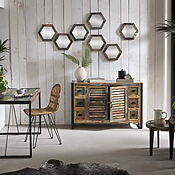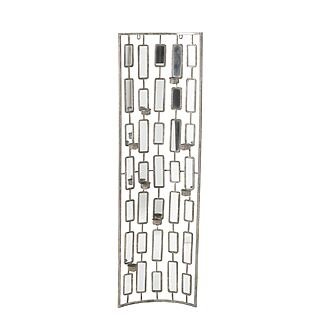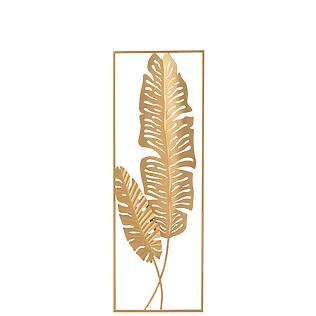Typographic elements are very much on trend. In fact, since the popularity of the "Keep Calm and Carry On" poster some fifteen years ago, the popularity of fonts and textual statements in home design has blossomed into a sustained enthusiasm for decorative text elements. A wooden letter decoration offers a stylish way to bring this look into modern living spaces.
Interestingly, the human brain perceives wall decorations as visually appealing starting at four words. Wooden letter wall decorations not only add a personal touch but also demonstrate creativity and individuality. Whether individual letters or entire sentences, typography transforms blank walls into expressive design surfaces. Fonts also play an important role, especially the distinction between sans-serif and sans-serif fonts.
This creative form of decorating with wood requires some time, careful consideration, and a clear intention. We'll show you how to create impressive effects with wooden letters on the wall, what design options are available, and how to harmoniously integrate solid wood accessories into your interior.
Basics of stylish typography in the living room
Typography lends living spaces a personal touch and always reveals something about the people who live there. While many people perceive letters primarily as a means of communication, they also hold enormous decorative potential.
What is typography?

Photo by Brett Jordan @brett_jordan, via Unsplash
Typography deals with the selection of fonts, colors, and sizes, as well as factors such as line length and type style. It is one of the most complex phenomena in graphic design, yet an integral part of our everyday lives.
Wooden letter decorations and similar typographic elements are not only decorative and informative; they also have the ability to subconsciously influence us in an emotional way.
Serifs & Fonts
One of the fundamental distinctions in fonts is between sans serif and serif fonts. These small decorative strokes or lines (also called "feet") at the ends of the main strokes of letters add additional visual complexity to the text. They can also be seen as a playful form of embellishment.
The different types of serifs —from soft, rounded Venetian serifs to sharp, thin neoclassical forms—create different atmospheres. Serif fonts like Times New Roman or Garamond , while sans serif fonts offer a modern, clean look.
Why is this important? Quite simply: when designing a living space, the desired character of the room should be taken into account when choosing wooden letters or other forms of typography for wall decoration .
Color choice and material: wood, metal, canvas
Wooden letters for decoration are available in numerous variations. The material palette ranges from MDF hardboard to fine woods like mahogany. Natural 3D letters impress with their wood grain. In addition to the natural wood color, versions in black, white, red, gray, or green are also available.
Other materials are also available as an alternative to wood: Alu-Dibond letters with a brushed surface in gold, aluminum, or copper finishes are even suitable for outdoor use due to their weather resistance. Acrylic letters with a high-gloss finish exude an elegant and sophisticated look, while concrete letters with their smooth surface create a modern character.
Depending on their thickness or depth, they can be placed upright, attached to the wall, or simply leaned against something.
Design ideas with wooden letters
Exciting moods and effects can be achieved using various design techniques.
Large individual letters as eye-catchers
In spacious rooms, large letters have a better effect and are ideal for large wall surfaces and staircases.
Initials, mottos, or greetings carved in large wooden letters lend rooms a distinctive character. Words like "home , "love," or "family" particularly inviting in the living room. Alternatively, the family name or an inspirational phrase can be placed above the sofa to personalize the room.
Scrabble style: Words as mural

The Scrabble look is very popular for wall decoration. Using wooden letters in the crossword style, family members' names can be arranged in a crossword-like manner, creating dynamic structures.
Typographic elements can be beautifully combined with other interior design elements. One creative option is to use stencils to place typographic elements on furniture such as dressers, tables, or cabinets. Romantic declarations or inspirational quotes can thus appear on painted furniture or on the sides of dressers and cabinets.
Wooden letters can also be combined with shelves and other home accessories for decorative purposes. Placing plants, candle holders, or vases between the letters creates a harmonious overall look. Illuminated with small LED string lights creates a particularly atmospheric effect.
DIY and creative ideas for making things yourself
Homemade wooden letters add a personal touch to living spaces. Anyone can create their own typographic decoration with a little creativity and the right tools.
Design and paint your own wooden letters
Proper preparation is key to achieving a professional-looking finish. First, it's important to clean the wood surface and then sand it with sandpaper . This step smooths the canvas and allows the paint to adhere better. It's advisable to apply a primer to seal the wood pores before painting.
Popular techniques include:
- Monochrome design in soft shades
- Glittering decoration for special highlights
- Mixing different color nuances
- Stencils and templates
create your own letter stencils using programs like Microsoft Word "Times New Roman" recommended. The stencils can be printed out, cut out, and attached to the piece of wood with removable spray adhesive.
Magnetic letters for the fridge
Magnetic letters can be made from old computer keyboards or letter game pieces. Small disc magnets, after being thoroughly cleaned, are attached to the back with magnetic glue. Materials like polymer clay can also be a good choice for creating custom magnetic letters.
Tips for a harmonious spatial effect
Decorative letters should work within the context of the entire room. A harmonious appearance is achieved through thoughtful placement and harmonious proportions.
Pay attention to proportions and placement
The crossword-style layout creates dynamic structures that make walls appear alive. Also, keep in mind that you shouldn't place the letters too close together—a little spacing helps the individual elements stand out better.
In large-scale arrangements, spacers are a practical aid to ensure that the wooden letters are arranged parallel and evenly.
Choose fonts that match the interior design style
Consider the interior design style when choosing suitable wooden letters. Light woods like birch or maple appear welcoming and airy, while dark woods like walnut or teak embody elegance and coziness.
The function of the room also plays a role: in the dining room, terms such as “enjoyment” , “appetite” or “cooking” appropriate, whereas in the living room “relaxation” , “together” or “reading” are .
Solid wood accessories as a complement
Interior design professionals recommend using no more than three different types of wood in a room with multiple solid wood home accessories . Warm-toned wood works best with other warm colors, while cool tones can be combined with cool colors.
Plants, candlesticks, or vases can be placed between the letters to create an additional sense of depth and vibrancy. Carpets or colored walls act "buffer zone"

Owner and Managing Director of Kunstplaza. Journalist, editor, and passionate blogger in the field of art, design, and creativity since 2011. Successful completion of a degree in web design as part of a university study (2008). Further development of creativity techniques through courses in free drawing, expressive painting, and theatre/acting. Profound knowledge of the art market through years of journalistic research and numerous collaborations with actors/institutions from art and culture.

















